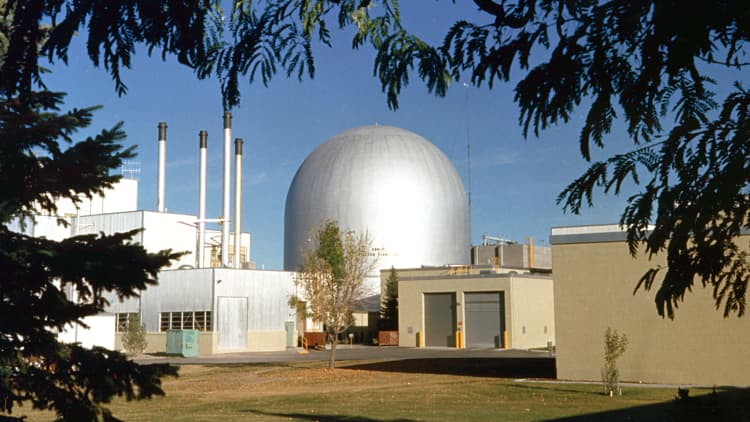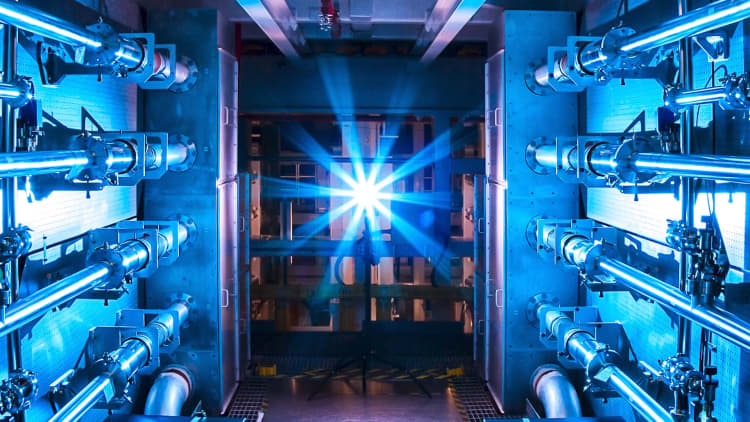
Nuclear reactors have a well-earned reputation for being massive construction projects that frequently run into cost overruns. Plus, once they are eventually constructed, monitoring and maintaining them takes a staff of dozens of trained experts.
But Yasir Arafat believes nuclear power doesn't have to be this way.
Arafat is the technical lead of the microreactor project at one of the United States government's preeminent nuclear research labs, Idaho National Lab, and in his role there, Arafat is leading the effort to build a tiny, relatively inexpensive nuclear reactor. It's more of a nuclear battery, he says.
Arafat grew up in Bangladesh before coming to college in the United States, and he's motivated by a deep sense of urgency to help the world decarbonize. The effects of global warming are not discussed as some distant future scenario in Bangladesh — climate change is already a part of current daily life. Nuclear energy does not generate any greenhouse gas emissions, and Arafat hopes to contribute to the solution by building a microreactor prototype that can help the development of the industry.
The prototype will be called the MARVEL reactor, an acronym for the name of the project Microreactor Applications Research Validation and Evaluation, and the goal is to have the first one operating by December 2023, making it the first advanced microreactor in the United States, Arafat told CNBC. (These photos show a prototype of the MARVEL reactor which runs with electric heat, not nuclear heat, for the sake of preliminary research.)
The Idaho National lab started designing and modeling the MARVEL reactor project in June 2020 under Arafat's leadership. If completed, the MARVEL microreactor "will be the first of its kind that will be able to demonstrate how we can really miniaturize a nuclear system into something that is portable and transportable, and also able to deliver heat and electricity to the end customer," Arafat told CNBC in a video interview in Idaho in May.
Already there are a slew of private companies — including Oklo, Westinghouse (where Arafat worked for a decade) and General Atomics — developing microreactors, and their goal is the same as the government's: To develop an emissions-free, reliable energy source.
A single microreactor could power a community from 1,000 to 10,000 people, whether that's a hospital or remote military base. The current electricity grid in the United States is based on a system of generating electricity at a centralized location and distributing it to the end users. But microreactors are a component in a future vision for the electricity grid that is less centralized more resilient against natural disasters.
Beyond being potential clean-energy options for remote locations or small communities, microreactors could be a key part of a future clean energy grid that includes renewable solar and wind energy and battery storage, Arafat said. Nuclear is a baseload energy source, meaning it can provide energy when the wind isn't blowing and the sun isn't shining, serving as a backstop for the intermittency of renewables.
Smaller = cheaper
Small modular nuclear reactors are orders of magnitude less complicated to construct and build than conventional light water reactors. Microreactors take that even further.
"The entire hardware can be built in a factory, like the way we make automobiles or cars," Arafat told CNBC, allowing for the production of hundreds of microreactors a year. From the factory, a microreactor can be transported to a customer location, fueled up and started. The goal is to be able to deploy a microreactor in less than a week, "so it's more like a nuclear battery than a large scale power plant," he said.
"If we become really good at manufacturing these systems and take advantage of factory fabrication, we can make them cheap enough for every campus across the nation," Arafat told CNBC.
Microreactors use a different kind of fuel enriched to just below the 20% limit set by nuclear non-proliferation requirements. This fuel, called HALEU, or high-assay low-enriched uranium, allows for the reactor to be smaller.
"We can actually build a much more efficient core that is significantly more compact and smaller. So we would actually require a much smaller amount of fuel to design a reactor rather than a much larger core. That's the biggest advantage of going higher enrichment," Arafat said.
The small size and factory fabrication means that micronuclear reactors will be much cheaper to construct than conventional light water reactors, which chronically run overschedule and overbudget. The third and fourth reactors being constructed at the Vogtle plant in Georgia have become infamous examples of such overages.
That's not to say the first microreactors off the factory line will be as cheap or fast as the technology will become. But they will likely be deployed at locations where there aren't cheap and reliable clean energy alternatives, like remote communities in Alaska.
"Currently, the only technology that works there are diesel generators and they have to fly in the diesel fuel in those locations. That's how remote they are. If we can replace those diesel generators with a micro reactor like this, it can certainly be significantly more economical than what they're currently paying today," Arafat told CNBC.
Also, because microreactors will be located near where energy will be used, the cost of transmission will be virtually nil, Arafat said.
Microreactors also require fewer personnel and less maintenance work than traditional reactors, in part because their fuel needs to be replaced only five to ten years, versus less than two years for a light water reactor, Arafat says.
Then, there's the safety piece. The microreactor is designed so that many of its systems operate passively.
"So everything from heat generation, heat transport, heat removal to heat rejection, all of those coolant loops are done passively without any engineered systems," Arafat told CNBC.
Also the side of the reactor is boron carbide, which is the same material used in armored vehicles.
"So if there's a manmade or an extreme weather conditions that can come through, there's going to be little or no effect to the actual operation or safety of these systems," Arafat said.
A critical piece of a larger puzzle, but no panacea
While Steve Nesbit, President of the industry trade group, American Nuclear Society, supports the idea of micronuclear reactors and the MARVEL project specifically, he cautions that they're not going to be a panacea for decarbonization.
That's largely because a conventional light water reactors generate hundreds of megawatts of energy and a microreactor will generate between one and five megawatts of energy, according to Arafat.
"I do think they have a future but there are limits to the ability to address our clean energy needs with them," Nesbit told CNBC. "Microreactors are ideally suited for remote situations with microgrids, but not so much as a means of gigawatt scale generation of clean electricity for the conventional grid."
The same view is shared by nuclear innovation expert and professor Alex Gilbert.
"They are distributed energy resources, meant to serve off-grid customers, small towns, and industrial operations," Gilbert told CNBC. "Alaska is likely to be an early initial market, as well as other parts of the Arctic like Canada, Russia, and Scandinavia. They can play keystone roles in microgrids, complementing distributed solar and batteries."
But many of the key issues that face the development of microreactors are the same that face the development of large scale nuclear in the US: "We have an atrophied supply chain, costs will be high and unpredictable to start, and the regulatory system is poorly suited to handle them," Gilbert said.
That said, addressing these issues for the deployment of microreactors can help to pave the way for those same issues "for large-scale roll out of larger advanced reactors," Gilbert said.
Arafat knows that the MARVEL project has a larger purpose: Flexing the muscles of nuclear innovation in the U.S. for the first time in decades. "So the art, science, and the technology of going through the development of new reactors is also sort of a new realm for us in many ways," Arafat told CNBC.
— CNBC's Magdalena Petrova contributed to this report.



